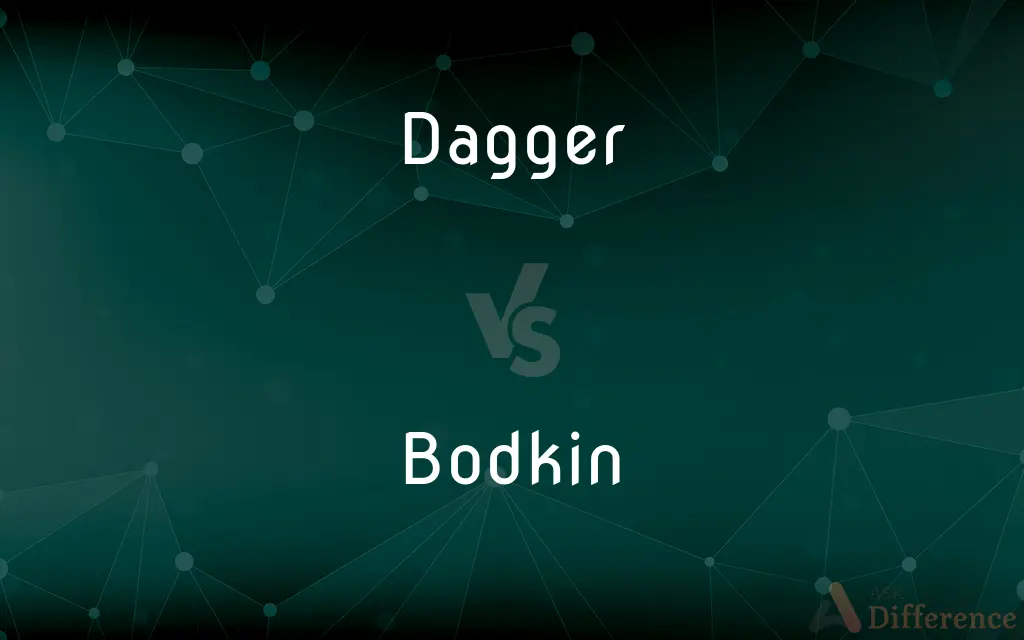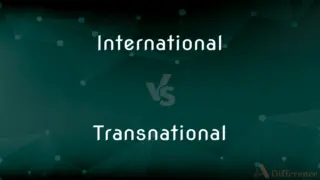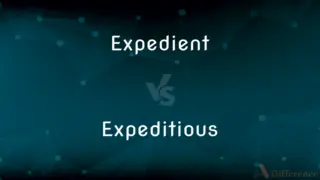Dagger vs. Bodkin — What's the Difference?
By Maham Liaqat & Urooj Arif — Updated on March 10, 2024
A dagger is a double-edged thrusting knife used for stabbing, whereas a bodkin is a small, pointed tool or needle, or a medieval single-edged weapon.

Difference Between Dagger and Bodkin
Table of Contents
ADVERTISEMENT
Key Differences
Daggers are characterized by their sharp, double-edged blades designed primarily for stabbing or thrusting. These weapons have been used throughout history for close combat, and their design allows for quick, piercing strikes. On the other hand, a bodkin can refer to two distinct items: a small, pointed tool used for piercing holes in cloth or leather, or a type of medieval arrowhead or dagger with a narrow, elongated blade, designed for penetrating armor.
While daggers are versatile weapons that can be used in a variety of fighting styles, bodkins (in the context of weaponry) were specifically developed to penetrate the chain mail and armor of medieval knights. This specialization made bodkins essential in warfare, especially during the Middle Ages, whereas daggers have been used across different cultures and time periods for both military and personal defense.
The construction of a dagger involves a hilt, guard, and a blade that is sharp along both edges, making it effective for both slashing and stabbing. Bodkins, when used as weapons, have a simpler design with a single-edged blade that tapers to a point, optimized for piercing rather than cutting.
In modern contexts, the term "bodkin" is more commonly associated with the tool used in sewing or leatherworking, reflecting its primary function as a piercing instrument. Meanwhile, daggers remain symbols of stealth and combat, often featured in historical reenactments, martial arts, and ceremonial occasions.
The cultural significance of daggers has evolved, with these weapons often depicted in literature and film as tools of assassins or warriors. Bodkins, however, have maintained a more utilitarian image, whether as tools of trade or medieval weapons, their portrayal is generally more functional and less romanticized.
ADVERTISEMENT
Comparison Chart
Definition
A double-edged thrusting knife for stabbing
A small, pointed tool for piercing or a narrow weapon
Primary Use
Stabbing or close combat
Piercing fabric or penetrating armor
Design
Double-edged blade with a hilt and guard
Pointed, often single-edged blade or tool
Historical Context
Used across various cultures and periods
Medieval weapon or tool for sewing
Modern Context
Symbol of combat, featured in reenactments
Sewing tool or historical reference
Compare with Definitions
Dagger
A short knife with a pointed and edged blade, used as a weapon.
He carefully placed the dagger back into its sheath.
Bodkin
A blunt, thick needle with a large eye used for threading ribbons or cords.
She threaded the ribbon through the bodkin to add it to her dress.
Dagger
An implement in traditional ceremonies, representing power or authority.
The leader held the ceremonial dagger aloft, symbolizing justice.
Bodkin
In literature, often referenced as a tool of trade or weapon.
The tailor reached for his bodkin, his most trusted tool.
Dagger
A piece of equipment in various martial arts and historical reenactments.
The fighters demonstrated their skill with swords and daggers.
Bodkin
A sharp, pointed tool used for making holes in leather or cloth.
He used a bodkin to puncture holes for the laces.
Dagger
An award or recognition in certain fields, symbolized by a dagger-shaped pin or decoration.
The journalist received a dagger award for her investigative reporting.
Bodkin
A term used historically to describe a small, pointed instrument of various uses.
The craftsman's bodkin was essential for his detailed work.
Dagger
A symbol of betrayal or danger, often used metaphorically.
His words were like daggers to her heart.
Bodkin
A medieval dagger or arrowhead designed to penetrate armor.
The museum displayed a bodkin next to the chain mail, illustrating its use.
Dagger
A dagger is a knife with a very sharp point and usually two sharp edges, typically designed or capable of being used as a thrusting or stabbing weapon. Daggers have been used throughout human history for close combat confrontations, and many cultures have used adorned daggers in ritual and ceremonial contexts.
Bodkin
A small, sharply pointed instrument for making holes in fabric or leather.
Dagger
A short knife with a pointed and edged blade, used as a weapon
He drew his dagger and stabbed the leader
Bodkin
A blunt needle for pulling tape or ribbon through a series of loops or a hem.
Dagger
A moth with a dark dagger-shaped marking on the forewing.
Bodkin
A long hairpin, usually with an ornamental head.
Dagger
A short pointed weapon with sharp edges.
Bodkin
(Printing) An awl or pick for extracting letters from set type.
Dagger
Something that agonizes, torments, or wounds.
Bodkin
A dagger or stiletto.
Dagger
See obelisk.
Bodkin
A small sharp pointed tool for making holes in cloth or leather.
Dagger
A double dagger.
Bodkin
A blunt needle used for threading ribbon or cord through a hem or casing.
Dagger
(weapons) A stabbing weapon, similar to a sword but with a short, double-edged blade.
Bodkin
A hairpin.
Dagger
(typography) The text character †; the obelus.
Bodkin
A dagger.
Dagger
A point scored near the end of the game (clutch time) to take or increase the scorer's team lead, so that they are likely to win.
Curry's last-minute 3-point dagger silenced the criticism for his so-called failure to come up big in big moments.
Bodkin
A type of long thin arrowhead.
Dagger
A timber placed diagonally in a ship's frame.
Bodkin
(printing) A sharp tool, like an awl, formerly used for pressing down individual type characters letters from a column or page in making corrections.
Dagger
To pierce with a dagger; to stab.
Bodkin
Closely wedged between two people.
To sit bodkin
Dagger
A short weapon used for stabbing. This is the general term: cf. Poniard, Stiletto, Bowie knife, Dirk, Misericorde, Anlace.
Bodkin
A dagger.
When he himself might his quietus makeWith a bare bodkin.
Dagger
A mark of reference in the form of a dagger [
Bodkin
An implement of steel, bone, ivory, etc., with a sharp point, for making holes by piercing; a stiletto; an eyeleteer.
Dagger
A timber placed diagonally in a ship's frame.
Bodkin
A sharp tool, like an awl, used for picking out letters from a column or page in making corrections.
Dagger
To pierce with a dagger; to stab.
Bodkin
A kind of needle with a large eye and a blunt point, for drawing tape, ribbon, etc., through a loop or a hem; a tape needle.
Wedged whole ages in a bodkin's eye.
Dagger
A short knife with a pointed blade used for piercing or stabbing
Bodkin
A kind of pin used by women to fasten the hair.
Dagger
A character used in printing to indicate a cross reference or footnote
Bodkin
See Baudekin.
Bodkin
A dagger with a slender blade
Bodkin
Formerly a long hairpin; usually with an ornamental head
Bodkin
A small sharp-pointed tool for punching holes in leather or fabric
Bodkin
A blunt needle for threading ribbon through loops
Common Curiosities
How were daggers used historically?
Historically, daggers were used for personal defense, close combat, and as symbols of power or status across various cultures.
What makes a dagger distinct from other knives?
A dagger's distinct features include its pointed, double-edged blade, designed specifically for thrusting and stabbing in close combat.
Can daggers be used for purposes other than combat?
Yes, daggers can also serve ceremonial or symbolic purposes, and in some cultures, they are part of traditional attire or rituals.
Do modern military forces use daggers?
While not as prevalent as in the past, daggers or combat knives are still part of the equipment in modern military forces for utility and close combat situations.
Were bodkins effective against all types of medieval armor?
Bodkins were especially effective against chain mail and lighter armors, but their effectiveness could vary against plate armor.
Is there a specific way to hold or use a dagger?
Effective use of a dagger typically involves gripping it firmly and using thrusting motions, capitalizing on its design for piercing.
Can a bodkin be considered a weapon?
Yes, in historical contexts, a bodkin could refer to a medieval weapon designed to penetrate armor, besides its common use as a piercing tool in sewing.
What are the materials used to make bodkins and daggers?
Both bodkins and daggers can be made from metals such as steel or iron. Bodkins used in sewing are also sometimes made from bone or plastic.
What is the significance of a dagger in literature and film?
In literature and film, daggers often symbolize betrayal, danger, or the character of a warrior or assassin.
What is the main difference between a dagger and a bodkin?
The main difference is in their design and use: a dagger is a double-edged stabbing weapon, while a bodkin can be a piercing tool or a medieval weapon with a narrow blade.
Is the bodkin still used today?
As a tool, the bodkin is still used today in sewing and leatherworking to thread or pierce materials. The weapon form is primarily of historical interest.
Are daggers legal to own?
Laws vary by country and region, but daggers can be subject to regulations regarding their possession, carry, and use.
How did the design of daggers evolve over time?
The design of daggers has evolved to incorporate various materials, decorations, and shapes, reflecting the technological, cultural, and functional changes over time.
Can bodkins and daggers be considered art?
Yes, both bodkins and daggers can be crafted with artistic detail, making them objects of aesthetic value as well as functional tools or weapons.
How is a bodkin used in sewing?
In sewing, a bodkin is used to pull cords, elastic bands, or ribbons through casings and hems.
Share Your Discovery

Previous Comparison
International vs. Transnational
Next Comparison
Expedient vs. ExpeditiousAuthor Spotlight
Written by
Maham LiaqatCo-written by
Urooj ArifUrooj is a skilled content writer at Ask Difference, known for her exceptional ability to simplify complex topics into engaging and informative content. With a passion for research and a flair for clear, concise writing, she consistently delivers articles that resonate with our diverse audience.














































